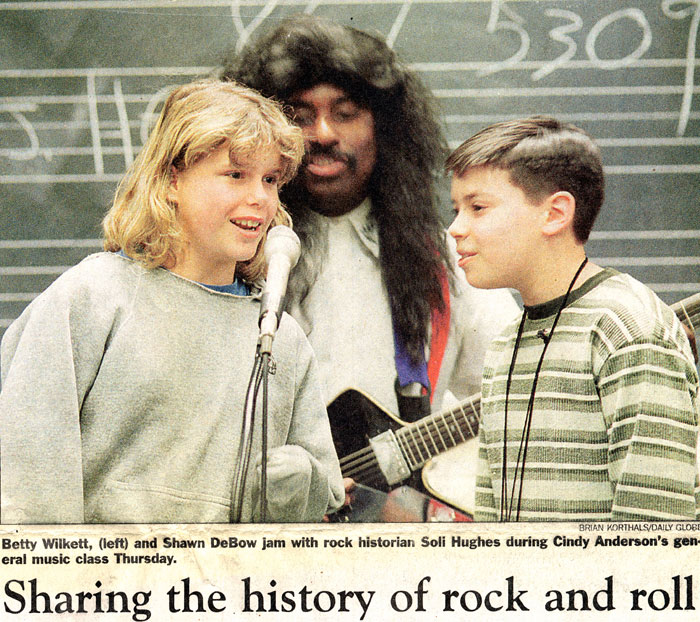Sharing the History of Rock and Roll
Artist jams with middle school students
By Juan Montoya
Daily Globe
WORTHINGTON – Hey, hey, my, my, rock 'n roll will never die.
This week, more than 400 students at the Worthington Middle School will learn that there's more to the music they listen to today than meets the eye.
In fact, they will learn that at its core, the music played by 'N Sync, and the Backstreet Boys harks back to artists from the 50s they have never heard about.
It's all part of an innovative concept by WMS general music and choir teacher Cindy Anderson through a grant by Southwest Minnesota Arts and Humanities Council, the McKnight Foundation and the Worthington Area Music Boosters.
"I grew up listening to that kind of music," said Anderson, as artist Soli Hughes, of Minneapolis, blew out the riffs on his electric guitar before a class of sixth graders.
"I love rock and roll," the students sang along with Hughes, long–haired and dressed the part, kicked out the jams in the best Joan Jett and the Blackhearts tradition.
It started with 50's rock on Monday, continued with the 60's on Tuesday, the disco days of the 70's Wednesday, and the electric 80's on Thursday.
Today, don't be surprised to hear the sounds of Britney and the Backstreet guys resounding through the school's corridors and to see students bee–bopping through the hallways.
"I tell students that rock and roll didn't start with the songs they listen to on MTV," said Hughes. "In fact, before the 1980s, there was no MTV."
Hughes, president and a performing artist with COMPAS, a nonprofit organization of Minneapolis, said musicians like him have been at it for the last 30 years and have visited between 1,500 to 1,600 schools since.
"We visit 100 to 200 schools every year," he said. "Basically, what we are doing is teaching the history of rock and roll and show how one decade influenced the other."
As a result of this relationship, he said, the background parts that made the 50's music so popular, like the doo–wop, transcended to rhythm and blues and can even be heard in turn–of–he–millennium music and in rap.
And as guitar became more popular in the 60's, it split into acid, folk and surf, each distinctively different.
"In the 70s, it split into soft and hard rock." Hughes aid. "And disco music had it's roots in rhythm and blues and soul."
"Music got really technical in the 80s," said Hughes during a break in his presentation. "Hair was really big, too."
Hughes comes well prepared to his task. A child of the 1950s, he grew up listening to Little Richard singing songs like Tutti Fruity.
On Monday, he came in the patent mohair pants and the tuxedo.
On Tuesday, for the 60's he showed up in the hippie style of Jimi Hendrix, complete with tie–dyed T–shirt.
"I actually met with Hendrix in New York during the early 1970's," Hughes said. "We never played together, but we talked of the crazy things that happen to musicians. He did have a pretty good three-piece band," he laughed.
Michael Casanova, 11, a sixth-grade student, said he was amazed at how much work went into the music.
"It was also funny how they dress up and stuff," he said.
Courtney Fodness, another 11–year–old sixth grader, said she didn't know it took so much work to get to where her favorite singer, Janet Jackson, got to be where she is.
"I learned a lot about stuff like tempo and beats," she said.
But all is not singing and props, said Hughes. Students are shown the cultural context and origins of the music that has evolved to today's sounds.
For example, he said that in the 50's, it was unheard for a woman to be blasting the jams on electric guitar like Patti Smith or Joan Jett.
"Or take the swearing," he said. "Even in the protest music of the 60s and the radical music of the 80s, there wasn't so much swearing as there is now."
Hughes and middle school students will hold a free concert at 2 p.m. Saturday at Memorial Auditorium.
Then on Monday, they will have a music court where students will judge which direction music will take in the future.
